Some time ago, I wrote about a particular fixture of my childhood, Asterix. This time, I will introduce you to another old piece of media that I grew up with: a video game. Lemmings, by Psygnosis.
My first contact with the series was when I was four when I saw my father play Lemmings 2: The Tribes on an Amiga computer. For some reason, the game sparked my imagination, even as I was too young to understand what was going on. But let’s not get ahead of ourselves. I’ll start at the beginning.
The very first game, which came out in 1991, had a very simple premise. The player had to guide the eponymous Lemmings through a 2-D, side-scrolling level. The Lemmings were odd critters, with pale pink skin, bright green hair and blue clothes. The design, I suspect, had a purpose similar to other games at the time — give them an easily-recognizable appearance in very simple graphics. They drop out of a floating trapdoor at the start of the level, and they need to reach a door at the end. Seems simple, but the devil, as always, is in the details. And they’re what makes the game so devilishly challenging, even 26 years later (holy cow, I’m old).
The player has no control over the Lemmings, who will blithely walk forward and suicidally stumble into their deaths. True to their name, which comes from a persistent myth about certain rodents. In order to prevent that grisly fate, the player has access to eight skills.
Climber can be assigned to a Lemming to let them scale vertical surfaces. Floaters use umbrellas as parachutes to survive falls that would splatter them. Blockers stand still and act as a barrier for other Lemmings; and this skill can’t be reversed, so they’ll stand there forever. Builders create a diagonal stairway. Diggers dig downwards, Miners dig diagonally, and Bashers dig forward. Bomber causes the Lemming to explode after five seconds, creating a crater around them.
Every skill has a number of uses in a given level, if it can be used at all. The numbers are determined for every level and can’t change. So it’s the player’s goal to work with the tools they get. The game rewards methodical planning, but sometimes you also need sharp reflexes, to assign a skill to a Lemming at just the right time. This is particularly true in later, more difficult levels.
That they were able to turn those simple building blocks and technology of the era into such brain-teasing puzzles over so many levels speaks to the designers’ fiendish cleverness. As much as I love this series, I can’t claim to have beaten it, or even most of it.
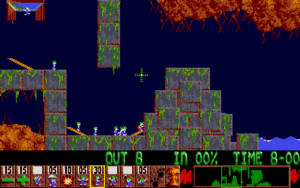
Still, like I said, the first Lemmings I played was actually the sequel. Lemmings 2: The Tribes put a new spin on the original premise. In the first game, each level was self-contained. You had a number of Lemmings, and there was a minimum quota you had to guide to safety in order to win. In Lemmings 2, levels were divided into twelve tribes, and there was a semblance of a plot.
A disaster threatened the Lemmings’ island, and they had to flee. To do that, they needed to assemble an amulet, and use it to power an airship. So each of the tribes had to bring their piece to the centre of the island. Each tribe had sixty members at the start, and any lemmings you lost wouldn’t show up in the next level. The tribes each had a unique level design and music, and some of them even differed in appearance. Inasmuch as they could with those graphics.
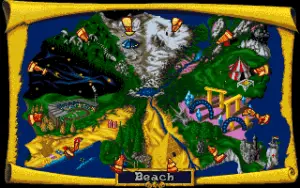
- Classical Lemmings looked just like they had in the first game, and their levels had the vaguely Greek, dark yellow decorations on a black background that many original levels had.
- Medieval Lemmings had a background of castles, walls and dragons.
- Egyptian Lemmings‘ levels were, predictably enough, Ancient Egyptian in design. Or, well, pop culture Ancient Egyptian.
- Outdoor Lemmings traversed through a green woodland area, with trees, leaves and monsters in the grass.
- Beach Lemmings had a theme of sea, surf and sand, and were one of the tribes with a different appearance. their skin was darker, to represent a tan.
- Sports Lemmings had to contend with levels built out of metal pipes and all sorts of sport accessories.
- Shadow Lemmings had darker outfits than others, and skulked through what looked like a modern city at night.
- Cave Lemmings had no special appearance, and moved through dark, neolithic caverns filled with fossils and skeletons.
- Space Lemmings, to no one’s surprise, had levels that looked like space stations.
- Snow Lemmings had white hair, and traversed arctic climates with obligatory snowmen and bears.
- Highland Lemmings had perhaps the most unique appearance, with bright red hair. Their levels likewise had a distinctly Scottish theme.
- Circus Lemmings looked plain, and their levels were full of clowns, tents and circus cannons.
The tribes are more or less cosmetic sets of levels, but the big change from the first Lemmings are the skills. Instead of eight, there are fifty one of them. You still only get a maximum of eight in a given level, however.
Some of them are, needless to say, highly specific. There is, for instance, a Super-Lemming skill, that lets a Lemming fly like Superman, with the player controlling their movements with a mouse. It’s a highly versatile movement skill. Then there’s archer, that fires arrows. They’re precise, but short. Some skills are very similar to the basic ones, with differences in size or range, like digging forward with a club or sword, which differ from the original Basher in how tall the tunnel is.
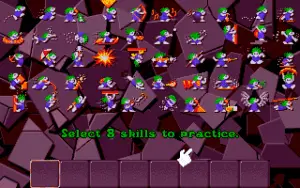
The player also gets an extra tool in the form of a fan, which blows air from the cursor. Some skills, like para-gliding or spinning, need the fan to provide them momentum and direction. As we can see, Lemmings 2 provided a whole new spin on the original idea. The idea was still to guide Lemmings to the end, but new skills and different victory conditions provided for a new experience.
The franchise had another major game, All New World of Lemmings. I remember my father buying it. On five floppy disks. Good times. The game followed Lemmings 2, and told the story of the Lemmings settling down after fleeing their homeland. They flew their airship to a far-away archipelago, where, of course, a whole new set of dangers awaited.
The game was fairly ambitious, for its time. The basic version contained three tribes: Classical, Shadow and Egyptian. More were meant to come in expansion packs, but they never happened. The visual differences between them were much greater than in Lemmings 2, as the visuals improved in general.
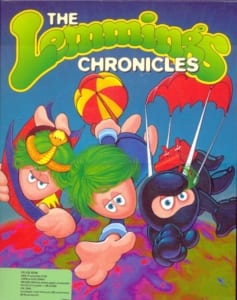
Classical Lemmings retained their original appearance, and their levels took place in some sort of futuristic facility, overgrown by a jungle. Shadow Lemmings dressed in ninja costumes, like on their artwork in Lemmings 2, but moved around an old-timey Wild West mining town at night. They also skulked, instead of walking floppily like other Lemmings. Egyptian Lemmings had appropriate costumes, complete with snake tiaras, and moved in the sideways step associated with Egyptian art.
The gameplay changes are much more significant, though. There are now only five skills on the bar: walk, jump block, use and drop. They have no limits to their use, and change gameplay significantly. Lemmings can now stop blocking whenever they want. Being able to jump freely lets them clear obstacles that would stop them cold in the previous games.
The “use” command replaces more sophisticated skills. It allows Lemmings to use tools they find. But, of course, they first need to find them. This adds a whole new layer of planning. The tools include shovels, which Lemmings use to dig horizontally, diagonally or vertically. Bricks let them build, likewise in any direction. Suction cups let them scale vertical surfaces or hang onto ceilings. Umbrellas let them fall slowly, and water wings let them swim. Thus covering all the original skills, plus some from Lemmings 2. There are also weapons, however, which are a new addition. Bombs are planted in place and explode after a moment. Grenades require throwing, and bounce a few times. Hadokens are fireballs that fly straight, killing enemies, but sparing Lemmings.
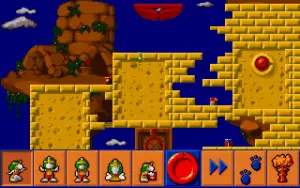
Yes, enemies. All New World of Lemmings is the first game in the series to include enemies, rather than traps and obstacles. Granted, they just wander in place and kill any Lemmings that run into them, so the difference isn’t that big. There are dire potatoes, who simply walk around; vultures that fly back and forth and attack Lemmings below. Then there are, uh… femme fatales. They resemble female Lemmings (not that the actual Lemmings have any indication of gender), and attack by enthralling the players Lemmings, causing them to commit suicide out of unrequited love. I’m not making this up, so let’s just move on. The fourth enemy is a mole, which is harmless; it just digs through the earth. This can be advantageous or inconvenient, and some levels require directing the moles’ tunnels by placing brick walls in their way. They won’t dig through, but instead turn around.
I do wish sometimes that All New World of Lemmings had received more support. I would have liked to see more tribes in the new style. And it’s hard to say if the new mechanics made for a better or worse game. Regardless, it was the last traditional one that Psygnosis released.
There are some spin-offs. First is Lemmings Paintball. It’s, well, it’s what it sounds like. Instead of a side-scrolling puzzle, it’s an isometric one. You control a maximum of four Lemmings, with paint guns and a very low supply of ammunition. There are no skills other than the paint guns, which you use to defend yourself from other Lemmings. Who, I might add, can shoot until the cows come home. Better supply lines, I guess.
Another is Lemmings 3D, which is an attempt to bring the original experience into the third dimension. The results are a mixed bag. The three-dimensional levels are much more complex, but divided into very clear square blocks. A new skill is necessary, which acts like the Blocker, but instead has the Lemming direct others to their left or right. A major part of the difficulty came from camera controls. Its handling wasn’t the best, and often necessitated using the “Virtual Lemming” mode, where the camera looked out of a Lemming’s Eyes.
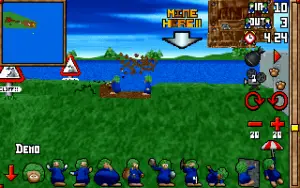
Then there’s Adventures of Lomax, which is your usual 90s side-scrolling platformer. There’s not much I can say about it, as I’ve only played it briefly.
Finally, in 2000, Lemmings Revolution came out. It was a return to the original experience, with the same skills and self-contained levels, but without the added dimension and camera control of 3D Lemmings. The title isn’t just for show, though, as levels are now each on a revolving cylinder. So while Lemmings still move in two dimensions, the game adds a revolving element.
That was the end of the series, more or less. People still remember it fondly, but no more spin-offs or versions have come out. It belonged to a different era, perhaps. Its pace was much slower than what modern games, even puzzle-oriented ones, give us. There was a lot of trial and error. You tried, you failed… and failed some more, until you cracked that one level. When I first played Lemmings, I was much too young to really do it, and I was never good at solving puzzles at the best of times. I did get better at it later, but I still don’t have the patience and analytical thinking.
Still, the games will forever have a place in my heart. In fact, as I write these words, I feel like firing them up again somehow. I hope that I’ve kindled an interest in this old relic of a bygone era of games. I miss you, little green-haired folks.

